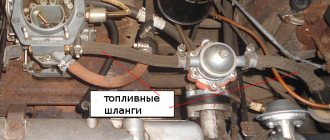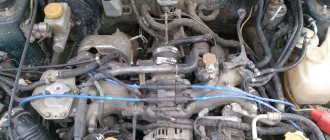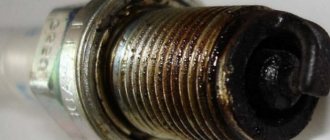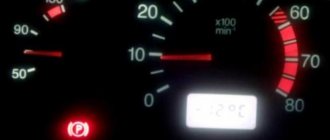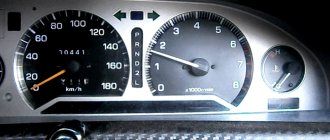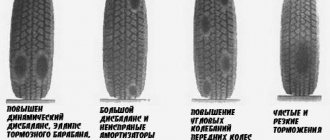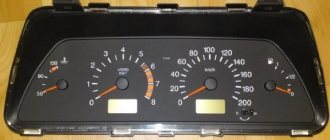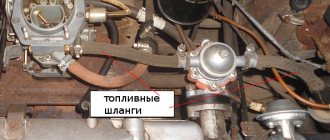General concepts
One of the most common troubles that prevents you from fully driving a car is the idle speed sensor of the VAZ 2110 and modifications. Although this device is called a sensor among drivers, it will still be correctly called the idle speed controller, abbreviated as IAC, because all automobile sensors are measuring equipment, and this product serves to automatically stabilize and maintain idle speed by supplying air to the engine VAZ 2110 with the throttle valve fully closed.
IAC is an important component of the engine and plays a significant role in the stable and uninterrupted operation of any VAZ vehicle.
Idle speed control
The VAZ 2110 idle speed sensor (abbreviated DXX) is an actuator, simply a valve consisting of an electric motor, a spring, and a rod on which a shut-off needle is installed (you can see it in the photo). It is through which the volume of air is dosed. That is, when the throttle of a VAZ 2110, 2112 is completely closed, and the controller determines that the idle speed needs to be increased, the IAC generates a command to change the position of the needle. It moves, partially or completely opening the intake port, through which air bypasses the throttle and then mixes with fuel. As a result, the engine does not stall.
Malfunctions
There are two main reasons why an alternator stops charging properly.
| Cause | Peculiarities |
| Device overload | This happens to those who like to install numerous additional equipment that is powered by a generator, that is, it requires electricity. These could be speakers, electric pumps, video devices, etc. A standard generator is not designed for such loads, and therefore loses efficiency |
| Battery and alternator mismatch | To ensure the operation of electrical equipment additionally installed on the car, many decide to install a more powerful battery with a standard generator. A mismatch in power leads to the fact that the generator ceases to provide proper charging to the more powerful battery. So he simply does not have enough resources for this |
What charge does the generator produce?
Many people are interested in the question of how much a generator should produce for normal operation.
Here the parameters directly depend on the current state of the car.
- If the engine is cold and just turns on, then the voltage will normally be 14.1-14.4 Volts;
- If you check the voltage after long trips in traffic jams, then the generator will produce less, about 13.9-14.1V.
Idle speed sensor design
Composition of IAC:
- a small electric motor with a stepper type action;
- a rod with a calibrated thick needle-shaped cone and a spring;
- terminals for the block.
Device role
On injection engines that are installed on the VAZ 2110, the XX regulator serves to control the stable operation of the power unit. It is unlikely that you will be pleasantly surprised by a situation in which the idle speed starts to fluctuate, and every now and then the car will stall.
Some people do not know about another very important role of the idle speed sensor - warming up the power unit in case of low air temperature.
Advertisements
It is generally accepted that if there is an injector, there is no need to warm up the engine. The opinion is wrong. Do not overstress the engine, but first let it run for a while without increased speed. This will have a positive effect on the reliability and service life of the motor.
How does it work and how does it not work?
The sensor, or idle air control, is designed to dose air into the intake manifold while the throttle valve is closed.
Idle speed sensor disassembled.
The device is not too complicated. It consists of a stepper electric motor, a calibrated spring-loaded cone and a rod. Installed in the intake manifold after the throttle valve. It is this regulator that is responsible for the smooth and smooth operation of the engine at idle speed.
Sensor on the throttle assembly.
Simply put, the idle air control sensor is a simple valve or actuator that controls the flow of air when the throttle is closed, according to commands from the electronic engine control unit. When starting the engine in cold weather, the ECU opens the idle speed control slightly and supplies more fuel to the combustion chamber, increasing the speed to speed up the engine warm-up.
Principle of operation.
Once the engine warms up to operating temperature, the stepper motor moves the conical valve stem forward and reduces the amount of air consumed, thereby reducing the speed. This is how the sensor works.
Signs of sensor malfunction
But it does not work in cases where:
- the engine does not hold idle, the speed fluctuates;
- the engine stalls at idle and when driving in neutral with the throttle closed;
- a cold engine does not start without an open throttle, that is, until we press the gas pedal, the engine will not start;
- low and unstable idle when the engine warms up.
In this case, the Check Engine light will not light up. If it lights up, then we look for the cause in the throttle position sensor. In the case where the symptoms are present, but the lamp does not light, the cause should be sought in our sensor. Therefore, now we will check its functionality.
Floating speed: reasons
Note that in some cases the revolutions do not just slowly fall or remain at the same level, but “float”. In this case, the engine may become unstable. Floating speeds first fall, then increase sharply and everything repeats. A common cause of this phenomenon is the supply of excess air, which leads to “jumps” in speed.
Such problems arise if the air supply sensor (MAF) fails, which allows the ECU to calculate how much air is supplied and how much fuel is supplied to prepare the required mixture.
If malfunctions occur, the control unit cannot prepare the “correct” mixture for the idle mode, which causes speed jumps after releasing the gas pedal or when the engine is idling.
Checking the idle air control
One of the reasons that the car stalls at low speeds is a malfunction of the idle air control (IAC). It should be tested to either rule out this cause or troubleshoot. There are several ways to check the serviceability of the IAC on the VAZ-2110:
- With the ignition off, connect the multimeter probes to the power supply. When they are connected, turn on the ignition and check the integrity of the winding and the power supply circuit in the following order: first, the probes are connected to pins 1 and 2. When the IAC is working properly, readings from 50 to 80 ohms appear on the multimeter sensor. When testing the 2nd and 3rd pins, as well as the 1st and 4th pins, there should be indicators indicating an infinite value.
- Visual inspection method. It is necessary to remove the regulator, disassemble it and determine the degree of coking, the degree of wear of the spring and other elements of the regulator. It is quite easy to visually determine that the regulator is simply time to change.
- It is still possible to carry out diagnostics using special testers, but purchasing such a tester will cost much more than replacing the part itself. It's up to you to decide whether it's worth purchasing such a device.
Messages 11
1 Topic by dmitrpost 2014-08-26 08:52:40
- dmitrpost
- New member
- Inactive
- Registration: 2014-08-26
- Messages: 5 Thanks: 0
- Car: VAZ2110
Topic: VAZ 2110 does not hold speed when cold
Good afternoon. 1. At an ambient temperature below +12C, I start the car, the revolutions rise to 1500 and hold for 5-10 seconds, then drop to 500 and the car stalls. We have to rev up the gas. After warming up a little, the revolutions rise to 2000 and do not fall until I turn off the car. I changed the IRR, TPS, cleaned the throttle - the result did not change. 2. When I shift into neutral from 3rd or 4th gear and coast, the revs rise to 2000 until it comes to a complete stop. As soon as I stop, the revs are restored to 800. Please help me with advice.
2 Reply from broslav_a 2014-08-26 09:42:43
- broslav_a
- Participant
- Inactive
- From: Crimea
- Registration: 2014-07-14
- Messages: 96Thanks: 18
- Car: VAZ 21102
Re: VAZ 2110 does not hold speed when cold
3 Reply from dmitrpost 2014-08-26 09:50:46
- dmitrpost
- New member
- Inactive
- Registration: 2014-08-26
- Messages: 5 Thanks: 0
- Car: VAZ2110
Re: VAZ 2110 does not hold speed when cold
4 Reply from Anton 2014-08-26 11:42:32
- Anton
- Local
- Inactive
- Registration: 2014-02-20
- Messages: 2,207Thanks: 255
Re: VAZ 2110 does not hold speed when cold
is there no air leak?
5 Reply from klimashov.roman 2014-08-27 09:25:33
- klimashov.roman
- Connoisseur
- Inactive
- From: Kasimov
- Registration: 2014-04-21
- Messages: 743Thanks: 143
- Car: GAZelle 33023 dv 405.22, 2.4 16kl 140hp
Re: VAZ 2110 does not hold speed when cold
Which TPS did you install? Set it to contactless, it should help.
6 Reply from dmitrpost 2014-08-27 09:34:46
- dmitrpost
- New member
- Inactive
- Registration: 2014-08-26
- Messages: 5 Thanks: 0
- Car: VAZ2110
Re: VAZ 2110 does not hold speed when cold
- klimashov.roman
- Connoisseur
- Inactive
- From: Kasimov
- Registration: 2014-04-21
- Messages: 743Thanks: 143
- Car: GAZelle 33023 dv 405.22, 2.4 16kl 140hp
Re: VAZ 2110 does not hold speed when cold
I didn't check the temperature sensor. And check the ground contact between the TPS and the mass air flow sensor.
8 Reply from dmitrpost 2014-09-25 09:35:43 (2014-09-25 09:36:44 edited by dmitrpost)
- dmitrpost
- New member
- Inactive
- Registration: 2014-08-26
- Messages: 5 Thanks: 0
- Car: VAZ2110
Re: VAZ 2110 does not hold speed when cold
The problem with starting the car has not been resolved. Rxx, non-contact TPS, cleaned the throttle, checked it for 100% on the computer - no errors were found, changed the high-voltage wires and spark plugs, the pressure in the fuel system is normal + replaced the fuel filter. We checked all the sensors - they work. There is no result. Moreover, when the air temperature is +4 in the morning, the car starts and immediately stalls, you have to rev it up. Minutes later 5, the check light comes on and flashes. I warm up the car to 90 degrees, turn it off and start it again - the check light does not come on. Does anyone have any thoughts?
Source
Testing the mass air flow sensor (MAF)
Let us remind you what we are talking about - VAZ-2110 8-valve injector: the speed drops and stalls. A reasonable question arises: what to do? If the reason is not the IAC, then it is worth testing the mass air flow sensor. Here are some recommendations on how to do this:
- Disconnect the sensor connector from the on-board system. The controller that controls the engine will operate in emergency mode, but for short testing this is not fatal. If your car runs much faster, then the problem is most likely in the mass air flow sensor. It's time to clean it.
- Replace the sensor with a working one, and then see how the engine works. There are improvements, which means you need to either clean or replace your own mass air flow sensor.
- It also makes sense to inspect the air intake; to do this, you need to remove the mounting clamp and carefully inspect the inside of the air intake, there should be no condensation or oil there. If any are found, then it will have to be cleaned with special means.
- You can also test the mass air flow sensor using a multimeter. To do this, you need to switch the multimeter to voltmeter mode and set it to 2. The sensor has 2 wires - yellow and green. Yellow transmits a signal to the controller, and green transmits a signal to ground. When the ignition is turned on, we take measurements between these two wires. The engine should not be running. If the readings are in the range of 1.01-1.02, then the sensor is in perfect order. Readings in the range of 1.02-1.03 – it’s time to clean the sensor. And if the indicators go off scale to 1.04, then it’s time to get a new sensor.
We recommend: Arranging the exterior of your car
Checking the serviceability of the throttle position sensor (TPS)
Our problem may be caused by a faulty DPSD. But it is this sensor that is tested last, when everything has been tried and tested. But in vain, it is easy to test, you can save a lot of time and money if you check this sensor. How to do it:
- This sensor is located on the throttle pipe, it is connected to the throttle axis. The sensor is secured with two screws. When removing the sensor, you should pay attention to the condition of the throttle valve, whether it is coked. If yes, then there will be the same symptoms as with problems with the sensor. However, the sensor can be checked without removing it.
- To do this, you need to measure the voltage at the DPSD terminals when you turn on the ignition, and it should not exceed 0.7 V.
- Next, open the throttle using the plastic sector, and then measure the voltage again. It must be at least 4 V.
- Next, check the voltage at the DPZD terminals when the damper moves. It should not change; abrupt changes indicate a sensor malfunction.
Having found out that the sensor is faulty, it should be replaced. On the VAZ-2110, 2 types of DPZD are installed - film-resistive and non-contact. The first is designed for 55 thousand mileage, the second is unlimited, but much more expensive than the first.
Replacement procedure
Replacement is carried out in the following order:
- We de-energize the on-board system by removing the negative terminal, which is located on the battery;
- Disconnect the block from the sensor. For a VAZ injector this happens by pressing a plastic latch;
- We unscrew two screws, and it is recommended to first unscrew the left fastener, then the right one;
- Now the regulator has been removed and there is no problem in replacing it with a new one;
- Before installation, it is advisable to spread oil on the sealing ring. See if there are even the slightest cracks on the ring, in which case it needs to be replaced;
- There is also no difficulty in the calibration procedure; the electronic relay will do everything. You just need to turn on the ignition for a few minutes and then turn it off. After this, the speed usually no longer fluctuates, and the car works without failures.
Description of battery operation
A battery is a device with the help of which electrical energy is obtained from chemical energy and vice versa, with the ability to accumulate and store charge. The main purpose is to provide power to the electrical equipment of an idle vehicle, as well as to start the engine using the starter. If the generator does not work or cannot cope with the load, the battery takes over its role. The generator does not allow the battery to discharge, as it is a source of recharging.
Based on the type of electrolyte, rechargeable batteries are divided into two large groups: alkaline and acidic; based on the material of the electrodes, they are divided into:
- lead;
- zinc with the addition of silver;
- nickel-cadmium;
- iron-nickel.
Lead-acid batteries are the most popular. The principle of operation of the battery is simple: thanks to chemical processes, an electric current is generated, which is necessary to start the engine. A running motor receives electricity from a generator. In this case, electrical energy is obtained from mechanical energy. The battery receives electricity from the generator and converts it into chemical energy, storing it for further use.
Checking the sensor yourself
The sensor is located in the throttle body and to remove it for inspection, you just need to unscrew two screws.
To dismantle the IAC, you need to disconnect the block and unscrew two screws.
Before dismantling, you need to thoroughly clean the place of its attachment from dust and dirt and remove the negative terminal from the battery. But first, a check.
Sensor connection diagram.
We look at the connection diagram and check the sensor using a conventional multimeter in the following sequence:
- Check for power supply to the sensor. To do this, measure the voltage at the two outer contacts of the block, A and D. Turn on the ignition, place the black probe of the multimeter on the engine ground, and the positive probe on the contacts one by one. The voltage should be within 12 Volts. If it is less or absent altogether, we look for an open circuit or blame the electronic control unit for everything. But first, we check the voltage at the terminals from ECU 4 and 54. Here, naturally, there should also be 12 V.
The voltage is normal.- We switch the multimeter to ohmmeter mode and measure the resistance between contacts A-B and C-D on the sensor itself. As can be seen from the diagram, we are checking the resistance of the winding of the stepper motor of the regulator. Between the indicated contacts, the nominal resistance is from 40 to 80 Ohms, according to the factory rating - 53 Ohms.
- We check the electric motor for short circuit of the windings. To do this, measure the resistance at terminals A-D and B-C. The resistance should tend to infinity, that is, there should be no contact between the two windings. If there is resistance, no matter what the value, we conclude that the windings are short-circuited. This cannot be cured; we replace the sensor with a new one.
It cannot be said that this testing method 100% guarantees the functionality of the sensor; we only checked its electrical part. The mobility of the cone valve and the magnitude of its stroke are of great importance. And this can only be checked either at a special stand or with a special tester.
Checking the operation of the mechanical part of the sensor
To check, remove the sensor from the throttle assembly.
However, if the electrical part is in order, you can check the mechanical part of the regulator by eye:
- Unscrew the sensor and remove it from the throttle body.
- We connect the contact block to the sensor.
- Turn on the ignition. When turned on, the valve should move forward. If this does not happen, the rod is coked or the stepper motor is not working properly.
- We measure the distance between the sensor body and the conical valve - nominal 24 mm.
We measure the distance with a caliper.
If we removed the sensor from the car and the electrical test passed, but we still did not achieve mobility of the cone valve, we try to clean the regulator using a soft swab, a cotton swab and WD-40 penetrating lubricant or an aerosol carburetor cleaner. Good luck to everyone and stable idle speed in any weather!
Sensor with carbon deposits.
Soak the valve in cleaner.
Cleaned sensor.
Mechanical problems
Therefore, regardless of whether your car has a carburetor or an injector, it is better not to joke with the generator, but if malfunctions are detected, respond quickly to them.
Your site is annoying, go away yourself, write topics for real dummies, this doesn’t happen in AvtoVAZ, you need to approach the problem radically, in basins everything is not predictable. Tell me, I went through the entire generator, before this everything was ringing, everything is fine, the diodes are all working, but there is no current. We installed startvolt from another car, at idle 14.1 volts, I’m already sick of it, well, really, everything is fine with the original gene
The battery charge indicator lights up. I removed the terminals and the car stalled. The generator was tested at the stand and works fine. I re-tightened all the contacts and ground. Checked the fuses. What could be the reason?
Home / VAZ 2110 / Generator / Why does the VAZ 2110 generator not charge and how to fix it?
Problem with charging without load at idle 13.7 at the beginning then decreases to 12.8 With low beam 12.6 then decreases to 12.2 V according to BC I changed the tablet on the old brushes are almost not worn out, tightened the belt There is almost no result. BC I think it’s not lying, since at 11.5 V The radio stops working. Tell me what to watch and what to do. Thank you _________________Vaz 21113 2000 January 5.1_________________
What to watch and what to do, tell me Thank you
measure the voltage on the battery with a proven device. If the LV has already been changed, then you can call the diode bridge because of it. but in any case, you need to start with the correct measurement. And also: how long has this been going on? if it’s been a couple of weeks, measure the density in the battery; if it’s low (below 1.26), then there’s a problem. _________________ | ▌ ▌ █ █ █ █▌ ford focus club █▌█ █ █ ▌ ▌|
On the forum for 7 years
From: Volgograd region.
Car: VAZ-11170 2012 with air conditioner.
At XX on the generator PRAMO 80A 13.8V, on the battery (new Tyumen 62a/h) - 13.6. I threw additional “+” and “-” from the battery to the generator - nothing changed. The masses are all cleaned and stretched. When all possible consumers are turned on, the voltage on the battery drops to 13.2, when the Carlson is also turned on - to 13.0. What else can be done or is everything normal and forget about this matter? _________________
blog
1. Measure with a cartoon tested on the stud and body genes. 2. measure under load at XX - i.e. turn on the BSF, heater fan, rear window heating.
on a working gene there should be: - 13.6 for conventional models -13.8 for Pramo -14.1 for the Shnivovsky gene (there is a tablet for Calcium batteries made there)
Next we look at what comes to the battery. if the loss is more than 0.1 Volt, we look for where it is lost.
It can get lost on wire crimps, contacts, and stud threads.
On the subject of Fur. part of the genes a lot of things have been written.
One by one, you can measure points under load with a cartoon and find places of losses. As a rule - oxidation.
According to the problem gene: 1. - Oxidation inside the gene and poor contact of the winding output with the horseshoe diode - it is advisable to solder the pigtail and throw an additional 1 cm of wiring from the winding to the sub-catcher (solder)
2. Tablet 3. Broken horseshoe diode. _________________ The world is full of “amazing” people. No matter how disappointed you are in people, they will still surprise you.
Diagnosis of IAC mechanics
The mechanics may be broken. The main thing that is checked during diagnosis is the mobility (length) of the bolt cone. The 100% condition of the device can only be determined with a special stand or a special tester, but an eye check can also reveal the cause of the problem.
Checking the sensor for mechanical service involves removing it. Procedure:
- We put the vehicle in handbrake.
- Remove the “–” terminal from the battery.
- Disconnect the block from the valve.
- We clean, wipe the place where the product was located, the fastenings.
- Unscrew the fasteners and remove the part.
Instructions on how to check the idle speed sensor on a VAZ 2110 (injector, 8 or 16 valves) after removing it:
- We connect the sensor to the block.
- We connect the battery.
- We activate the ignition - the cone shutter should move forward. If this is not observed, there may be a malfunction of the rod (possibly coking) or the motor. The norm for the protrusion of the needle (cone) from the body of the product is 23 mm. When operational, if power is supplied, the rod changes position.
We recommend: Which countries are best to travel to by car?
Cleaning DXX
You cannot ignore such a basic procedure as cleaning - this can give results, since sometimes parts of the product, contacts, become coked, covered with dirt and oil.
What you need for cleaning:
- cleaner (lubricant) WD-40 or similar cleaning products for equipment;
- cotton wool, clean rags, tampons.
Cleaning:
- The sensor is completely dismantled, with the block disconnected.
- The swab is moistened with the cleaning mixture. You can also spray the product with an aerosol.
- Carefully wipe the contacts, needle, and installation sites, especially if oil is found there.
Before installation, the regulator is dried, the protrusion of the needle from the body is measured (the norm is 23 mm).
If the sensor has a malfunction of the electrical part - the winding, the electric motor - then repair is impractical or impossible. They buy a new product, especially since it is not too expensive (on average 500–700 rubles, but can be found for 250–300 rubles).
If the problem is in the block with wires (you can buy a new one), loose contacts or contamination, then repair is advisable. Repair also makes sense if there are serviceable parts of an identical product - you can disassemble it and try to replace these parts. But we must take into account that usually such a repaired device breaks down more often and the inconvenience caused by this will be very unpleasant, so it is usually more profitable to immediately buy a new product.
Winding break
If the excitation winding is broken, then there is no charging of the battery. To determine this, it is often enough to place your hand on the generator. When it breaks, it heats up. For an accurate check, you need to disconnect the end of the excitation winding from the brush, connect the battery wires to it, and connect the battery wires to terminal Ш of the generator (via a voltmeter or a light bulb).
If there is a break, the voltmeter needle will not deflect and the light bulb will not light up. To find which of the coils prevents the generator from working, connect the wires from the battery to each individually. Finally, check the soldering and coil terminals. If the break is internal, the coil needs to be replaced; for external ones, soldering helps.
Step-by-step replacement procedure
The replacement procedure is carried out in almost the same way as cleaning the device, but there are certain nuances:
- The battery is disconnected to prevent a short in the wiring.
- The plug with the electrical circuit is disconnected from the control device. If the car is equipped with an injection power unit, then to disconnect the connector you need to press on the plastic fastener.
- The bolts are unscrewed. As when cleaning, first unscrew the left fastener, and then the right one. The failed regulatory device is being dismantled.
- The surface on which the sealing element is mounted is also cleaned. The latter is checked for defects - abrasions, cracks, etc. If they are present, the sealing gum is replaced with a new one. Before installation, the seal is treated with engine fluid, after which it is mounted on the throttle seat.
- The controller is installed, a connector with wires for its power supply is connected. A wire is connected to the battery.
- After installation, a calibration procedure is performed. The microprocessor module must perform this independently; an electronic relay is used for this. To calibrate the new sensor, the ignition is turned on for a few minutes and then turned off. If the actions performed helped and the speed no longer floats, but remains at the same level, then the replacement procedure can be considered complete.
What do you need to know when replacing the IAC?
To change and install a controller that allows you to regulate idle speed, you need to pay attention to the position of the rod. It must not be allowed to be pushed forward too much. This can happen if the device is connected to the block and the ignition is activated before installation. It is not allowed to push the rod in by hand.
If the valve is installed with the needle extended and the retaining screws are tightened, damage to the unit may occur due to shearing of the worm gear. It is impossible to repair such a sensor. Depending on the vehicle model, after installing a new regulator, it may need to be calibrated. In some cars, this procedure is carried out using special equipment or a stand.
On VAZ cars, calibration is performed as follows:
- A terminal is connected to the negative output of the battery.
- The key is turned in the lock to turn on the ignition for ten seconds. There is no need to start the power unit.
- The ignition is turned off.
Learning to distinguish a fake from an original
Today, many people complain about the abundance of counterfeit products on the auto parts market.
If we talk specifically about the XX regulator for the VAZ 2110, then there are several key signs by which a fake can be distinguished from the original. Be guided by these data so as not to accidentally install a device of dubious quality and origin on your car.
Fake and original
- On fakes, the black body made of metal is 1 millimeter shorter than the real part.
- In the case of the fake, the three white rivets on the case have no heads. They must be present in the original. And the diameter of the caps is 3 millimeters.
- On fakes, the spring is made in white and has more frequent winding. In the original, the coiling is less frequent, and the spring itself is black.
- Pay attention to the rubber ring of the regulator. On fakes it is black and thin, but in the case of a real part, a reddish tint is noticeable. Plus the thickness is greater.
- Take a closer look at the tip. In fakes it is darker compared to the original spare part.
- There are no markings on the counterfeit packaging; the boxes are noticeably different in appearance.
- The original yellow sticker located on the case must have an outer frame. Manufacturers of counterfeits apparently forgot about it.
As you can see, recognizing a fake is not difficult. You just need to be more attentive to details.
The difference is in the boxes
Generator faults
If there is no current leakage, and the trips are quite long, then the battery is not charging enough
It is important to know what kind of charging a working generator should provide. With the engine running, you need to check the voltage at the battery terminals
Without turning on additional electrical appliances, the voltmeter should show values of 13.5 - 14 volts, this is exactly the charge that a working generator should produce. If the voltage on the voltmeter is low (less than 13 volts), then you should begin to identify the reasons why the system is not giving a full charge.
The scheme for charging a battery from a generator is simple; it is often directly connected to the main output of the generator, using a thick cable, and sometimes even two.
If you have the proper knowledge, it is not difficult to identify generator malfunctions; this will require a minimum of tools. It is better to carry out the check according to the same principle of eliminating possible causes from simple and cheap to complex and expensive.
Belt tension
If the drive belt breaks or stretches over time, the generator will “slip” under load. The need for tightening is indicated by a whistle that disappears when the gas is applied.
The solution is to tighten the belt; depending on the design of the generator mounting, this procedure may differ. There are three types of tensioner: self-tightening spring tensioner, worm tensioner, and lever tensioner. Without proper belt tension, the situation will increasingly repeat when the car runs but does not charge the battery.
Bearings
The generator rotor rotates on bearings. If they jam or fall apart, the generator will not work. When replacing or tightening the belt, you should unscrew and shake the pulley; there should be no backlash, jamming, or extraneous knocks or hums.
To replace the bearings, the generator will have to be completely disassembled; you will need bench tools, a vice and pullers.
If the bearing falls apart, the armature touches the stator windings, resulting in a short circuit. As a rule, such a generator must be replaced.
Excitation check
In most cars, a separate live wire comes to the alternator to begin producing electrical current.
Replacing and calibrating a new IAC
Replacing the idle speed valve sensor on a VAZ 2110: the part is inserted, the screws are tightened, the leads are connected according to the diagram (available in the instructions for the IAC or on the network). The idle speed control of the VAZ 2112 has 16 valves and on other vehicles with a power system of a similar design, it is located in the same standard way.
It is highly advisable to calibrate the IAC after replacement:
- Ignition for 7–10 seconds, without starting during this time.
- Start the internal combustion engine. Jumps and increased speed may be observed.
- Turn off the engine - the rod will move to another extreme position.
- Repeat the described steps 2-3 times.
- Run the engine for approximately 5–7 minutes.
It must be remembered that the calibration is reset after disconnecting the IAC or after removing the negative terminal from the battery. This procedure will help the speed “stand up” more correctly for better functioning of the system.
Problems on the go
Now it’s time to deal with the problems that arise on the road. It happens that the engine stalls while driving. In this case, it is best to call a tow truck or enlist the help of other drivers to deliver the car to a garage or the nearest service station.
If you have some skills in handling cars, then you can check several suspected problem components and parts yourself:
- Spark plugs - they are almost always checked. If they are not working, replace them with new ones.
- A dirty fuel filter blocks the flow of fluid, resulting in a lack of fuel causing the engine to stop working. Check the filter, clean or replace it.
- The air filter may also become clogged. If this is the problem, you will notice not only unstable operation of the engine unit, but also a significant decrease in engine power, which occurs due to the fact that there is not enough air to create a high-quality combustible mixture.
- Serious problems can arise if the fuel pump is faulty. Insufficient pressure appears in the system, and the car begins to stall due to poor fuel flow into the combustion chamber. Check, repair or replace the part.
- The battery is another element that is very rarely checked after the engine is stopped. The operation of electronic devices rests on it; as soon as it is discharged, the machine will stop. The contacts of the device may also be oxidized, but they can be easily cleaned.
- After the battery, it is worth checking the generator. This could be the reason why the battery is discharged. The battery will have to be charged, and the generator will have to be repaired or replaced with a new one.
We recommend: How much oil to fill in a VAZ 2110 engine - the answer is here
We are looking for problems - the main culprits of the voltage drop
The problem is that your car may have a number of individual problems that lead to a drop in voltage. Therefore, only a specialist can tell the reason one hundred percent after examining the entire electrical circuit and performing high-quality diagnostics. Without inspecting the car, you can only guess the real problems and speak in general terms. However, there is a certain set of blocks and equipment that is responsible for voltage. This is what you should check first:
- battery - if this device is completely discharged, the computer tries to replenish its resources and sends the lion's share of the generated energy to charge and restore it;
- generator - a broken diode bridge can cause a significant drop in network performance, and this will cause problems with the battery in the future;
- voltage regulator (tablet) - installed on the generator and distributes voltage flows from this device; if it breaks, it can put an excessive load on the engine;
- too powerful equipment - for example, you could install a sound amplifier and subwoofer that the on-board electrical system of your car simply did not support;
- a failed consumer of electrical energy - this could be a burnt-out fan, a broken fuel pump, failed headlights, an air conditioner and other components.
Of course, this is not a complete list of possible causes of problems.
It is worth remembering the importance of proper operation of the electrical network. In case of malfunctions and constantly low voltage, a variety of troubles are possible, including burning of important parts and simply low reliability of the vehicle as a whole.
So it’s not worth driving with such a problem for a long time. You should immediately send the car to a service station or perform independent diagnostics.
Why does it start and stall?
If you turn on the logic, there may be several main reasons why the engine stalled after starting:
- insufficient amount of fuel;
- exhaust system malfunctions;
- failures in the formation of the air-fuel mixture and its supply to the injectors.
It can be assumed that the cause is faulty spark plugs or a clogged air filter. But spark plugs do not all fail at once. If one spark plug does not work, the engine starts to stall, but this will not cause it to stall. To clog the filter to such an extent that it is unable to pass air through itself requires a lot of effort. When there is no air supply, the engine will not start at all, and even if it does start, the thrust will drop significantly. Traveling would be difficult, if not impossible.
Exhaust system malfunctions
Everything is simple here: if you close the pipe tightly, the engine will stall after some time. Even if you start it again, it will run for a few seconds and then die again. This happens because the exhaust gases have nowhere to go: they cannot get out, and fall through the exhaust manifold back into the combustion chambers. There, the gases mix with the air-fuel mixture, ignition becomes impossible, and the engine stalls.
Exhaust gases are not removed for several reasons:
- catalyst malfunction (can also be heavily contaminated);
- water in the muffler.
The situation with a clogged catalyst is rare. To do this, the water in it needs to freeze, but this is unlikely.
But water in the muffler happens quite often. It freezes in winter and exhaust gases cannot escape. There are few reasons why water gets in. Basically, this is a broken cylinder head, which causes antifreeze to enter the exhaust system and, mixing with condensate, freezes. Although, if the cylinder head gasket is punctured, the problem of ice in the muffler will seem like a trifle, since more serious repairs await.
Incorrect fuel/air mixture
Such situations occur frequently. In this case, the engine either does not start at all, or runs erratically. There are few reasons, these are:
- incorrect operation of the throttle assembly;
- air intake in addition to the air duct in front of the air filter (suction).
The throttle valve is directly involved in the formation of the fuel mixture, and disruption of its functioning leads to malfunctions of the power plant. The air leak makes the mixture too lean, and the engine cannot work on it, which is why it stalls. To eliminate these problems, you need to clean the throttle assembly (or replace it if it is faulty) and look for the location of the air leak.
Insufficient fuel supply
The symptom is simple: after starting, the engine runs for 5–10 seconds and stalls. In most cases, the cause is the fuel pump located in the fuel tank. To be precise, the problem is a clogged fine filter or mesh. This detail, insignificant at first glance, does not allow dirt particles to enter the fuel line, which, like water in the gas tank, is abundant (especially on cars with a mileage of 50,000 or more).
In summer, the water and other substances in the tank are liquid and can pass into the main line, but in winter they often turn into ice on the mesh filter. This causes the fuel pump to be unable to pump enough fuel to run the engine. Therefore, it turns out that the pump manages to pump a little fuel, and this is just enough to start the engine, but no more. To eliminate this problem, it is enough to replace or clean the fuel pump mesh.
Troubleshooting options
It is clear that if any emergency situations arise with the motor, it is advisable to contact a specialized service. However, this procedure is not always possible. Therefore, it is worth knowing how to independently diagnose the main systems and key parts.
Throttle valve and assembly
When the speed drops at idle and the car stalls, you need to pay close attention to the details of the throttle assembly. Long-term operation of the car on low-quality fuel and untimely maintenance of the air filter can lead to malfunctions of the throttle valve. It periodically jams if debris gets into the equipment.
Throttle valve VAZ 2112
The problem can be solved by cleaning the system. The throttle is cleaned using carburetor cleaners. Using a compressor, you need to blow out the damper under the pressure of compressed air. It is not recommended to touch the screws located inside and on the side. If cleaning does not correct the situation, the device must be replaced. This operation is not particularly difficult.
Crankcase malfunction
There is an oil trap in the crankcase ventilation system of the engine. Its contamination can also lead to interruptions in engine operation. Crankcase gases do not allow the engine to function normally, the speed fluctuates, the internal combustion engine stalls.
Sensors
If a gasoline car stalls at idle, then one of the sensors is likely to break. In injection cars with an electronic engine control system, the engine usually starts normally, but then it stops working. It's worth checking here:
- Electronic car indicators;
- DRХХ – device that regulates idle speed;
- Air flow meter (air intake in the carburetor);
- Sensor indicating the position of the throttle curtain.
Electronic control unit in VAZ 2114
Interruptions in the operation of any sensors immediately affect the behavior of the electronics - errors appear in the car control unit. The “brains” of the machine receive unreliable information. It is not transmitted correctly to the engine. It starts working with parameters that do not correspond to reality. Self-testing of this device is not possible. You need to contact a professional for service.
The idle air control device is usually to blame for engine malfunction when the car idles poorly. But you pressed the gas pedal and the engine started. In the latest VAZ modifications, error information appears on the instrument panel.
When diagnosing, you must use a multimeter. If a part is faulty, it is recommended to replace it with a new one. All sensors are reasonably priced. It is better to start checking with parts that have a simpler design. Then gradually move on to complex devices. We must not forget that the problem may lie not only in the sensors themselves. It is also necessary to check the wiring to them and the presence of stable contact.
Carburetor
If the VAZ carburetor stalls at idle speed, then the jets may become clogged. Low-quality gasoline, deposits from the gas tank, contain small particles of debris. They can easily disrupt the operation of the fuel injection system. It is worth replacing the filter in front of the carburetor and cleaning the device itself. The dispensing part is cleaned using a cleaning solvent, which is sold in aerosol cans. Another reason is often a prolonged lack of carburetor adjustment.
Let's sum it up
As you can see, even taking into account the relative simplicity of the part itself, the IAC performs a number of important functions. Of course, if a malfunction occurs in the internal combustion engine, it is necessary to check this element. At the same time, for diagnostics and maintenance of the VAZ 2110 idle speed sensor, no specialized equipment is required. Also, replacing the XX regulator can be done with your own hands in a regular garage.
Finally, we note that sensors of this type are quite reliable and rarely fail. However, problems still arise on cars with high mileage. In any case, if the idle speed is disrupted, it is important to make sure whether the breakdown is really related to the IAC. The above information will allow the driver to quickly check the sensor (electronic and mechanical part of the idle air valve).
Sources
- https://KraiAvto.ru/vaz-2110/datchik-holostogo-hoda-vaz-2110-neispravnosti-proverka-i-zamena-rhh-vaz-2110/
- https://ladafakt.ru/net-holostogo-hoda-na-vaz-2110-inzhektor.html
- https://osensorax.ru/rashod-uroven/datchik-holostogo-hoda-vaz-2110
- https://ladaautos.ru/vaz-2110/chto-delat-esli-padayut-oboroty-i-gloxnet-vaz-2110-8-klapanov-inzhektor.html
- https://carfrance.ru/priznaki-neispravnosti-datchika-xolostogo-xoda-na-vaz-2110/
- https://prometey96.ru/ustrojstvo/vaz-2110-glohnet-na-hodu.html
